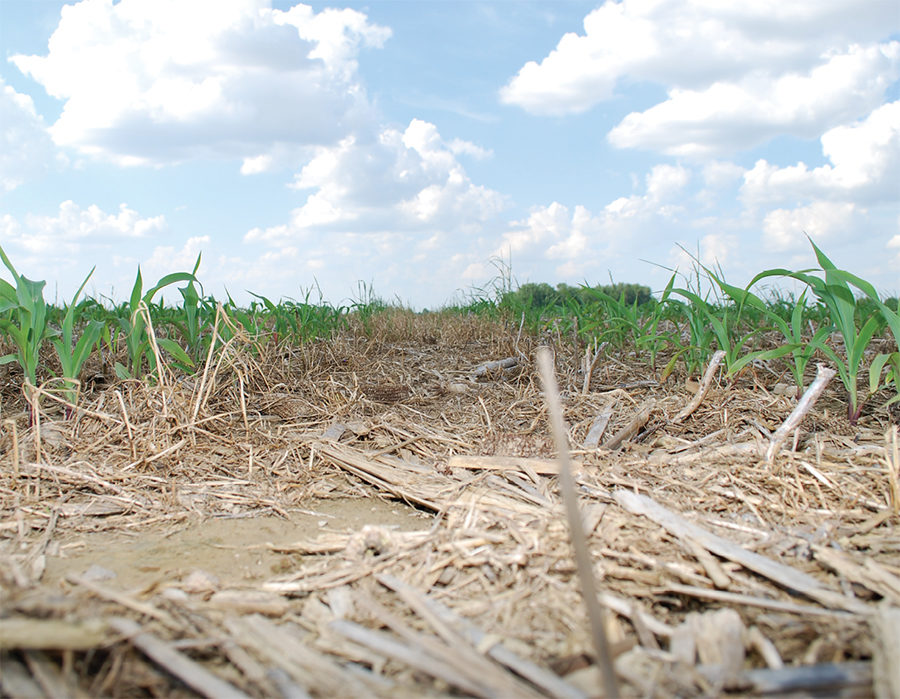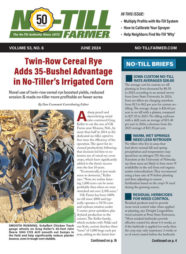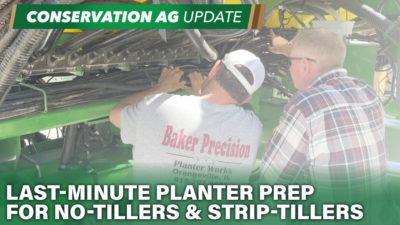One of the most neglected aspects of no-tillage seems to be the proper use of cover crops. Unfortunately, many farmers simply take this part of the total program for granted and unnecessary mistakes are often made.
Our No-Till Farmer editors recently asked several university agronomists for their ideas on the most common mistakes that no-till farmers make with cover crops. Here are their ideas on things you need to avoid:
1 Failure to seed a cover crop.
This results in costly soil erosion, moisture loss and poor weed control in the following no-till crop, says Morris Bitzer, University of Kentucky crops man. As farmers gain more experience with no-tillage, they realize the importance and benefits of seeding a cover crop.
2 Seeding cover crops too late.
Poor planning results in the summer crop remaining in the field too long. By using earlier-season soybean varieties or corn hybrids, the crop can be removed in time to get a cover crop seeded.
3 Poor cover-crop stands.
Better soil preparation and proper depth of discing can reduce this problem.
Bitzer suggests using higher seeding rates with late cover-crop seeding, as well as the proper amount of nitrogen, to help establish a fall-seeded crop.
“This would include the failure to adjust the pH for the legume cover crop,” says Bill Lewis, North Carolina State University weed man. “Fall moisture may also be more critical for legume seed establishment.
“The time over which legumes can be established is less than that for a small grain cover crop. In addition, legumes are more sensitive to low moisture conditions once they have germinated.”
4 Selection of improper cover crop.
There’s no easy answer on which cover crop is best to use. This depends on time of seeding, use of the cover crop and the specific crop that will be seeded next spring into the cover crop.
“Cover crops can be used to reduce erosion where crop residues are removed or sparse,” says L.S. Robertson, Michigan State University soil scientist.
“Oats planted in late summer-plowed fields provide a blanket to the soil while they are frozen. Rye is the old standby for those who don’t fall-plow and is very feasible with the use of modern-day herbicides.”
Rye, ryegrass, wheat, oats, barley and buckwheat are all recommended as cover crops for Michigan farmers.
“Rye, from many standpoints, is one of the easiest cover crops to establish,” adds Gene Krenzer, North Carolina State University crops specialist.
5 Failure to realize that some cover crops are better erosion fighters.
“As we go into the federal government’s 208 clean-water program, we’re concerned about a comparison of legume cover crops versus small grain cover crops for erosion control,” explains Lewis. “The legume cover crop does not provide as lasting a mulch as rye or wheat.”
6 Planting cover crops in fields heavily infested with difficult-to-control perennial weeds.
Johnsongrass or nutsedge are examples. Lewis and Krenzer recommend conventionally planting cover crops and using pre-plant incorporated herbicides in these fields.
“If possible, apply Roundup in the late summer prior to seeding a winter cover crop,” says Lewis. “In the case of soybeans, a recirculating sprayer could be used to control weeds which have grown above the soybean canopy.”
7 Killing cover crop prior to planting of no-till corn.
“The experienced no-tiller will plant the crop ahead of spraying down the cover crop,” advises Bitzer. “This results in a more uniform and accurate killing of the cover crop.”
However, agronomists in other areas of the country may suggest an earlier cover crop kill prior to planting.
8 Allowing the cover crop to get too tall in the spring.
The date a farmer plans on planting the spring crop will also determine the best cover crop to use.
Legumes are more appropriate for late planting, while small grains are recommended if a farmer plants early.
9 Mice damage to no-till corn.
This can become a problem when the cover crop has gotten too much growth prior to spring planting. If this happens, the cover crop should be cut high and removed for hay or silage before no-till planting in the spring.
10 Failure of growers to realize that nitrogen management for a corn crop may be more critical.
Under heavy mulch conditions, it is best to apply the nitrogen in two applications, says Krenzer. Apply one-third of the nitrogen at planting time and the other two-thirds of the nitrogen when the corn is at least several inches tall.
“Right now, we cannot confidently predict the amount of nitrogen supplied by a legume cover crop for the following corn crop,” says Lewis. “So this may contribute to difficulty in managing the amount of nitrogen needed.”
11 Failure to select the proper herbicides, rates or spray volume to kill a cover crop.
Krenzer, for example, says the kill of a legume cover crop may be improved by an application of Banvel or 2,4-D at least 3 days before applying paraquat.
Use at least 40 gallons per acre of spray solution. Spray nozzles and pressure should be used that will force the solution through the crop canopy.
12 Failure to control insects and recognize insect problems.
Use a soil-applied insecticide for control of many insects. Monitor the field for cutworms and armyworms. Be aware of new soil-applied insecticides that will control these two pests.
13 Growing a cover crop without specific use in mind.
Farmers in the irrigated or dryland Southern Plains can’t afford to grow a cover crop unless it is put to practical use.
“So growing a cover crop for the purpose of cover only would be a big mistake,” says Allen Wiese, Texas A&M University weed scientist stationed at Amarillo, Texas. “This is not true in eastern Texas, however.”
He explains that water from rain or irrigation in this area is expensive, scarce and must be used to produce a return. In the northwest panhandle of Texas, winter annual small grains serve the purpose of both cover (necessary to prevent wind erosion) and to furnish grazing for cattle.
“The biggest mistake that farmers make is destroying the crop residue cover that is left after harvest,” says Wiese. “Unless we have a crop failure, there is enough stubble to control erosion and, in many cases, to increase soil moisture storage in the ground.
“This cover is part of the crop and is free. But it is unfortunately wasted when plowed under. Yet this is not a no-till mistake — the mistake is the tillage.”








Post a comment
Report Abusive Comment